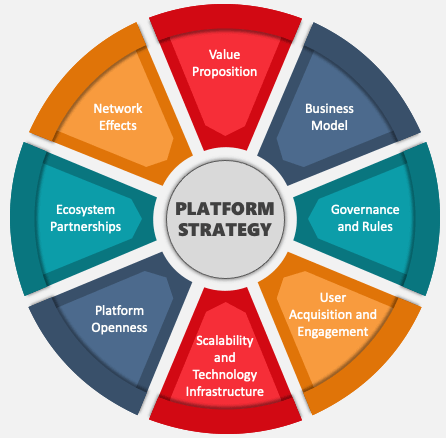
A platform strategy refers to a business approach that focuses on the development, management, and evolution of a platform - a foundation that facilitates interactions between different groups, often creating a marketplace or ecosystem. Platforms can take various forms, such as technology platforms, business platforms, or product platforms. The strategy involves defining how the platform will operate, attract participants, and deliver value. Here are key elements typically associated with a platform strategy:
Define the Platform:
Clearly articulate the purpose, scope, and value proposition of the platform. Understand what problems it solves or what opportunities it creates.Platform Components:
Identify the key components and features of the platform, including any core technologies, services, or functionalities.Ecosystem Development:
Define strategies for building and growing the ecosystem around the platform. This involves attracting users, developers, partners, or other stakeholders.Open vs. Closed Platform:
Decide whether the platform will be open (allowing external developers and contributors) or closed (controlled by the platform owner). This choice can impact the rate of innovation and the scale of the ecosystem.Monetization Model:
Determine how the platform will generate revenue. This could involve fees, subscriptions, transaction charges, or other monetization strategies.Developer Relations:
Establish strategies for engaging and supporting developers or contributors. This includes providing documentation, tools, and support to encourage the creation of applications or services on the platform.User Experience:
Design a user-friendly experience for all participants, ensuring that using the platform is intuitive and provides value.Scalability and Flexibility:
Plan for the scalability of the platform as the user base grows. Ensure that the platform can adapt to changes in technology, user needs, and market dynamics.Data Governance and Security:
Implement measures to govern and secure data on the platform. Address privacy concerns and comply with relevant regulations.Community Building:
Foster a sense of community among platform users and contributors. Encourage collaboration, communication, and knowledge sharing.Iterative Improvement:
Adopt an iterative approach to platform development, incorporating feedback from users and stakeholders to continuously improve the platform.Competitive Positioning:
Analyze the competitive landscape and position the platform relative to other offerings. Identify unique features or advantages that differentiate the platform.Regulatory Compliance:
Ensure compliance with relevant laws and regulations, especially in industries with specific regulatory requirements.Strategic Partnerships:
Explore opportunities for strategic partnerships that can enhance the platform's capabilities or broaden its reach.